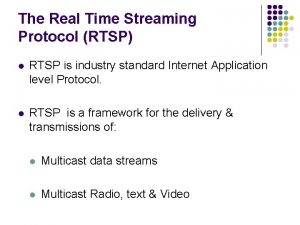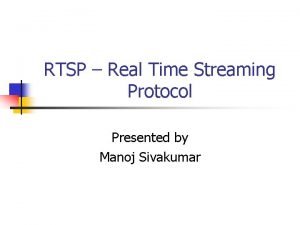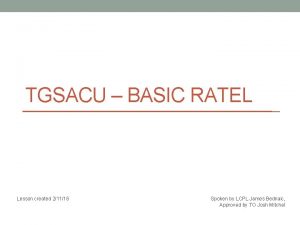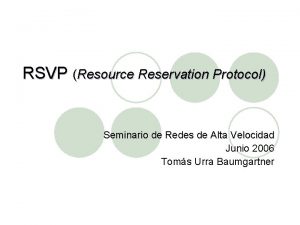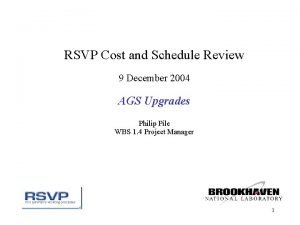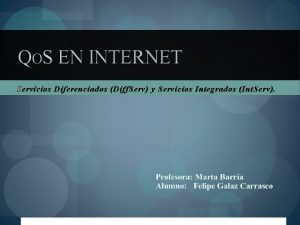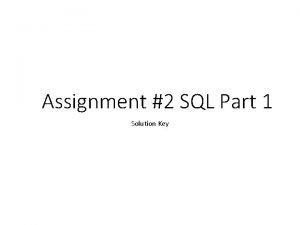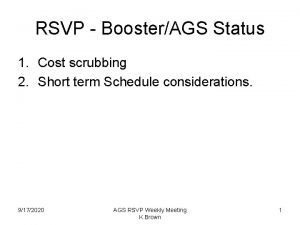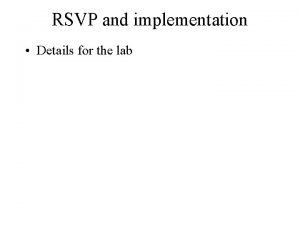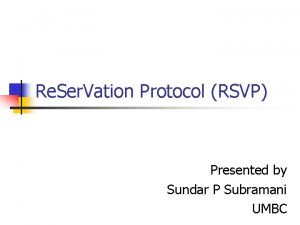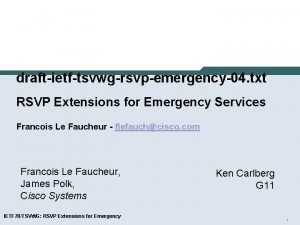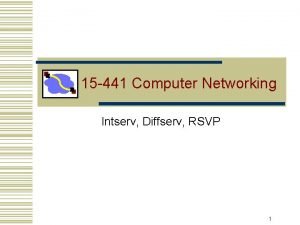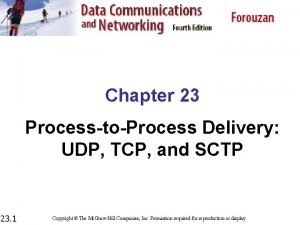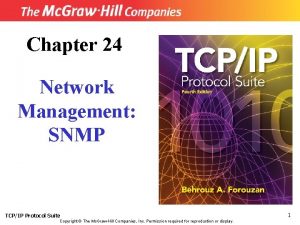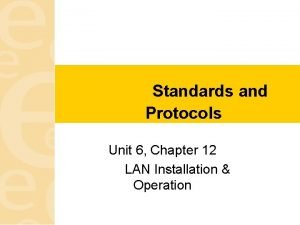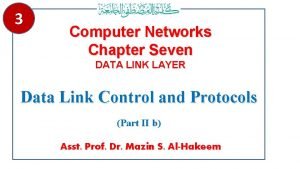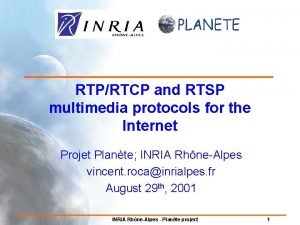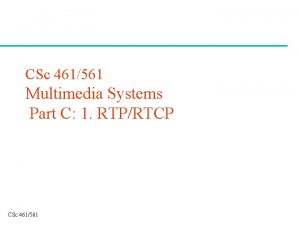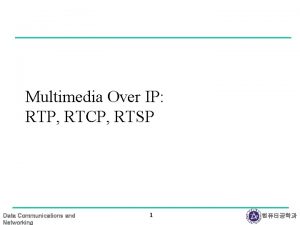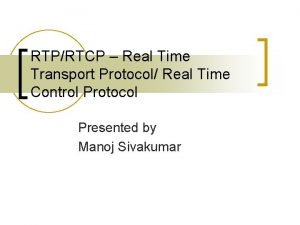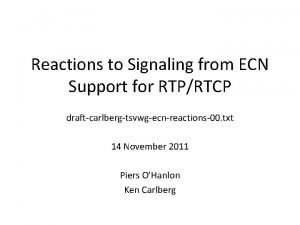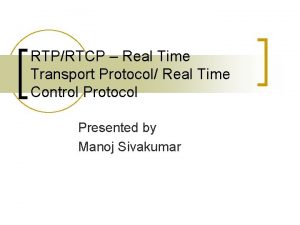RTPRTCP RTSP and RSVP Multimedia protocols for the








































- Slides: 40

RTP/RTCP, RTSP, and RSVP Multimedia protocols for the Internet Jim Chou and Thinh Nguyen

Outline of the presentation n n 1 - the context 2 - the RTP/RTCP protocols 3 - the RTSP protocol 4 - the RSVP protocol

PART 1: The context

A general view of the real-time protocols n the protocols and their application field… n stream description: SDP, SMIL. . . describe the session and content n stream control: RTSP remote control the session n media transport: RTP send data and metadata n resource reservation (if any!): RSVP, Diff. Serv make sure the communication path offers appropriate guaranties… …otherwise Best-Effort transmissions!

A general view… (cont’) n and the result…

PART 2: The RTP/RTCP protocols n n n 2. 1 Overview 2. 2 RTP generalities 2. 3 Header format 2. 5 RTCP generalities 2. 6 RTP profiles 2. 7 some implementations

2. 1 - Overview n IETF Audio/Video Transport WG n n n Real-Time Protocol (RTP) n n n RTPv 1 RFC 1889 (January 1996) RTPv 2 draft-ietf-avt-rtp-new-09. txt (March 2001) understand: « a framing protocol for real-time applications » does not define any Qo. S mechanism for real-time delivery! Real-Time Control Protocol (RTCP) n n its companion control protocol does not guaranty anything either!

Overview… (cont’) n Design goals: n flexible n protocol neutral n scalable n provide mechanisms, do not dictate algorithms! instantiations for H 261, MPEG 1/2/. . . UDP/IP, private ATM networks. . . unicast, multicast, from 2 to separate control/data some functions may be taken over by conference control protocol (e. g. RTSP)

2. 2 - RTP generalities n data functions (RTP) n content labeling n n source identification loss detection resequecing timing n n intra-media synchronization: remove jitter with playout buffers inter-media synchronization: lip-synchro between audio-video

Typical use n Usually. . . n n uses UDP (TCP is not for real-time!!!) no fixed UDP port negociated out of band UDP port for RTCP = UDP port for RTP + 1 usually one media per RTP session (i. e. port pair)

2. 3 - RTP header 0 1 2 3 4 5 6 7 8 9 0 1 +-+-+-+-+-+-+-+-+-+-+-+-+-+-+-+-+ |V=2|P|X| CC |M| PT | sequence number | +-+-+-+-+-+-+-+-+-+-+-+-+-+-+-+-+ | timestamp | +-+-+-+-+-+-+-+-+-+-+-+-+-+-+-+-+ | synchronization source (SSRC) identifier | +=+=+=+=+=+=+=+=+=+=+=+=+=+=+=+=+ | contributing source (CSRC) identifiers | |. . | +-+-+-+-+-+-+-+-+-+-+-+-+-+-+-+-+ n n n version (V) padding (P) extension (X) CSRC count (CC) marker (M) payload type (PT)

2. 5 - RTCP generalities n n periodic transmission of control packets several functions n feedback on the quality of data distribution n let everybody evaluate the number of participants n persistant transport-level canonical name for a source, CNAME n n n usually: user@host will not change, even if SSRC does! provides binding across multiple media tools for a single user

RTCP generalities… (cont’) n Five RTCP packets n SR sender reports tx and rx statistics from active senders n RR receiver reports rx statistics from other participants, or from active senders if more than 31 sources n SDES source description, including CNAME n BYE explicit leave n APP application specific extensions

RTCP generalities… (cont’) n distribution n n use same distribution mechanisms as data packets (n m multicast) multiple RTCP packets can be concatenated by translators/mixers compound RTCP packet n scalability with session size n RTCP traffic should not exceed 5% of total session bandwidth requires an evaluation of number of participants RTCP tx interval = f(number of participants) n at least 25% of RTCP bandwidth is for source reports let new receivers quickly know CNAME of sources!

SR RTCP packets includes n n n source 1 reports, there are 2 other sources RTCP packet SR sender report receiver report source 2 receiver report source 3 SSRC n SSRC of sender identify source of data NTP timestamp when report was sent RTP timestamp corresponding RTP time packet count total number sent octet count total number sent followed by zero or more receiver report… example: SSRC n

RR RTCP packets n includes n n n n SSRC of source identify the source to which this RR block pertains fraction lost since previous RR (SR) sent (= int(256*lost/expected)) cumul # of packets lost long term loss highest seq # received compare losses interarrival jitter smoothed interpacket distortion LSR time when last SR heard DLSR delay since last SR

PART 3: The RTSP protocol n n 3. 1 generalities 3. 2 an example 3. 3 a bit more in details 3. 4 some implementations

3. 1 - RTSP generalities n IETF standard n n Real-Time Streaming Protocol n n RFC 2326 acts as a « network remote control » supports the following operations: n n n retrieval of a media from a server invitation of a media server to a conference recording of a conference

RTSP generalities… (cont’) n Protocol design n n text-based protocol transport protocol independent supports any session description (sdp, xml, etc. ) similar design as HTTP with differences yet! n n client server and server client requests server maintains a « session state » data carried out-of-band works either with unicast or multicast

RTSP methods n Major methods n n n SETUP: server allocates resources for a stream and starts an RTSP session PLAY: starts data tx on a stream PAUSE: temporarily halts a stream TEARDOWN: free resources of the stream, no RTSP session on server any more Additional methods n n n OPTIONS: get available methods ANNOUNCE: change description of media object DESCRIBE: get low level descr. of media object RECORD: server starts recording a stream REDIRECT: redirect client to new server SET_PARAMETER: device or encoding control

3. 2 - Example: media on demand, unicast n Scenario… C client W A V media descr. web server audio server video server step 1: get description (in SDP format) step 2: open streams with RTSP step 3: play step 4: teardown

Example… (cont’) n Another view HTTP GET presentation description (sdp) client C web server W SETUP PLAY RTP audio/video RTCP TEARDOWN media servers A&V

PART 4: RSVP: Reservation Protocol

What is RSVP n RSVP is a network control protocol that will allow Internet applications to obtain special qualities-of-service for their data flows. n n This will generally require reserving resources along the data path(s). RSVP is a component of the future "integrated services" Internet, which will provide both best-effort and real-time qualities of service When an application in a host requests a specific Qo. S for its data stream, RSVP is used to deliver the request to each router along the path(s) of the data stream and to maintain router and host state to provide the requested service. Although RSVP was developed for setting up resource reservations, it is easily adaptable to transport other kinds of network control information along data flow paths.

Quality of Service n n Marking Queuing Policing Admission Control Diffserv: • Different classes of traffic marked appropriately (DSCP marking) • Queue accordingly

Quality of Service n n Marking Queuing Policing Admission Control At the trust boundary: • per user, per interface • per flow (RSVP)

Quality of Service n n Marking Queuing Policing Admission Control Is there over-subscription? : • of data (usually) • of voice (maybe – if yes – admission control is required – i. e. RSVP)

Admission Control - RSVP n RSVP is used for signaling end to end (admission control based on bandwidth, QOS requirements) n Per-Flow policing is rarely done in the core/backbone Instead: n n n In the access: Per flow reservation state is maintained; Per flow policing At the edge of the backbone: per flow policing, marking In the backbone: Queuing based on marking (DSCP, MPLS – i. e. reservation state is not maintained)

Quality of Service – Use of RSVP Per flow policing DSCP marking Diffserv Region Classify & schedule based on DSCP Backbone Access RSVP signalling Trust Boundary

RSVP Signaling RSVP Path RESV optional RESV CONF

Soft. Switch and RSVP n Softswitch controls how RSVP is used while it controls call signaling i. e. : n n Request reservations in both directions Don’t ring the phone until I get confirmation that reservations have been obtained

RSVP Basic Functionality n RSVP handles heterogeneous receivers. n n RSVP adapts to changing group membership as well as changing routes. n n Different hosts on the same multicast delivery tree may have different capabilities and therefore need different Qo. S. For dynamic adaptability and robustness, RSVP maintains “soft state” in the routers. The only permanent state is in the end systems, which periodically send their RSVP control messages to refresh the router state. In the absence of refresh, RSVP state in routers will time out and be deleted. RSVP is not a routing protocol. n The RSVP daemon consults the local routing protocol(s) to obtain routes. RSVP is designed to operate with existing and future unicast and multicast routing protocols. A host sends IGMP messages to join a multicast group, but it uses RSVP messages to reserve resources along the delivery path(s) from that group.

RSVP Operational Principles n A Qo. S request from an application is passed to the local RSVP implementation (user daemon). RSVP passes the request to all the nodes along the reverse data path to the destination. n RSVP provides transparent operation through routers that do not support it.

RSVP Operational Principles n At each node, RSVP applies a local decision procedure (admission control) to the Qo. S request. n n Each router in the path capable of resource reservation will pass incoming data packets to a Packet Classifier and then queue them in a Packet Scheduler. n n If admission control succeeds, it sets the parameters to the Classifier and Packet Scheduler to obtain the desired Qo. S. If admission control fails at any node, RSVP returns an error indication to the application. The Packet Classifier determines the route and the Qo. S class for each packet. The Scheduler allocates a particular outgoing link for packet transmission. For Qo. S-active link-layer media the packet scheduler is responsible for negotiation with the link layer to obtain the Qo. S requested by RSVP. n Mapping to the link layer Qo. S may be accomplished in a number of possible ways; the details will be medium-dependent. On a Qo. Spassive medium such as a leased line, the scheduler itself allocates packet transmission capacity. The scheduler may also allocate other system resources such as CPU time or buffers.

RSVP Operational Principles Ü RSVP is designed to scale well for very large multicast groups. – RSVP uses "soft state" in the routers, i. e. , RSVP sends periodic refresh messages to maintain the state along the reserved path; in absence of refreshes, the state will automatically time out and be deleted. Ü RSVP reserves resources for simplex data streams, i. e. , it reserves resources in only one direction on a link – A sender is logically distinct from a receiver. However, the same application may act as both sender and receiver. Ü RSVP mechanisms provide a general facility for creating and maintaining distributed reservation state across a mesh of multicast delivery paths. – RSVP transfers reservation parameters as opaque data (except for certain well-defined operations on the data), which it simply passes to admission control and to the Packet Scheduler and Classifier for interpretation.

RSVP Reservation Model n An elementary RSVP reservation request consists of a "flowspec" and a "filter spec"; this pair is called a "flow descriptor". n n The flowspecifies a desired Qo. S. It is used to set parameters to the node's packet scheduler, assuming that admission control succeeds. The filter spec, together with a session specification, defines the set of data packets -- the "flow" -- to receive the Qo. S defined by the flowspec. Filter spec is used to set parameters in the packet classifier. Data packets that are addressed to a particular session but do not match any of the filter specs for that session are handled as best-effort traffic. Please, note “upstream” and “downstream” convention!

RSVP Reservation Model n The flowspec in a reservation request will generally include a service class and two sets of numeric parameters: n n an "Rspec" (R for `reserve') that defines the desired Qo. S, a "Tspec" (T for `traffic') that describes the data flow. The formats and contents of Tspecs and Rspecs are determined by the integrated service model, and are generally opaque to RSVP. Filter specs may select arbitrary subsets of the packets in a given session. n Subsets might be defined in terms of senders (i. e. , sender IP address and generalized source port), n a higher-level protocol n any fields in any protocol headers in the packet. n Example: filter specs might be used to select different subflows in a hierarchically-encoded signal by selecting on fields in an applicationlayer header. n Current RSVP software does not yet support this option. Because the UDP/TCP port numbers are used for packet classification, each router must be able to examine these fields. n n

RSVP Reservation Model n RSVP reservation request messages originate at receivers and are passed upstream towards the sender. At each intermediate node, two general actions are taken: n Make a reservation n The request is passed to admission control and policy control. n n n Forward the request upstream n n If either test fails, the reservation is rejected and RSVP returns an error message to the appropriate receiver. If both succeed, the node uses the flowspec to set up the packet scheduler for the desired Qo. S and the filter spec to set the packet classifier to select the appropriate data packets. The reservation request is propagated upstream towards the appropriate senders. The set of sender hosts to which a given reservation request is propagated is called the "scope" of that request. Forwarded reservation request may differ from the request that it received from downstream: n n reservations for the same sender from different downstream branches of the tree are "merged" as reservations travel upstream; a node forwards upstream only the reservation request with the "maximum" flowspec. reservation might be purposefully modified by traffic control.

RSVP Protocol Mechanisms n RSVP Messages n Two basic RSVP message types: Resv and Path. n n n Each receiver host sends RSVP reservation request (Resv) messages upstream towards the senders. Resv messages must follow exactly the reverse of the routes the data packets will use, upstream to all the sender hosts included in the sender selection. Resv messages are delivered to the sender hosts themselves so that the hosts can set up appropriate traffic control parameters for the first hop.

RSVP Protocol Mechanisms n RSVP Messages n Two basic RSVP message types: Resv and Path. n Each RSVP sender host transmits RSVP Path messages downstream along the uni-/multicast routes provided by the routing protocol(s), following the paths of the data. n Path messages store "path state" in each node along the way. This path state includes at least the unicast IP address of the previous hop node, which is used to route the Resv messages hop-by-hop in the reverse direction.
 Rtsp voip
Rtsp voip Rtsp what is
Rtsp what is Rtsp protocol
Rtsp protocol Rtsp wiki
Rtsp wiki Multimedia streaming protocols
Multimedia streaming protocols Ratel speed test
Ratel speed test Washu habif
Washu habif What is the first rule in social correspondence?
What is the first rule in social correspondence? Que es rsvp en redes
Que es rsvp en redes Rsvp meaning
Rsvp meaning Rsvp cost
Rsvp cost Servicios diferenciados
Servicios diferenciados Rsvp movies sql assignment
Rsvp movies sql assignment Rsvp
Rsvp Rsvp
Rsvp Rsvp
Rsvp Rsvp
Rsvp Intserv diffserv
Intserv diffserv Multimedia def
Multimedia def Multimedia becomes interactive multimedia when
Multimedia becomes interactive multimedia when Chapter 1 introduction to multimedia
Chapter 1 introduction to multimedia Esa multimedia.esa.int./multimedia/virtual-tour-iss
Esa multimedia.esa.int./multimedia/virtual-tour-iss Proofs of work and bread pudding protocols
Proofs of work and bread pudding protocols Wan transport technologies
Wan transport technologies Cryptography standards and protocols
Cryptography standards and protocols Tcp and sctp are both layer protocols
Tcp and sctp are both layer protocols 5 network topologies
5 network topologies Snmp uses two other protocols
Snmp uses two other protocols Lan standards and protocols
Lan standards and protocols Lab 4-1: routing concepts and protocols
Lab 4-1: routing concepts and protocols Data link layer protocols for noisy and noiseless channels
Data link layer protocols for noisy and noiseless channels Routing fabric
Routing fabric 325181028 routing
325181028 routing Inter vlan routing layer 3 switch
Inter vlan routing layer 3 switch Plc norms
Plc norms Protocols and standards in computer networks
Protocols and standards in computer networks Chapter 3 network protocols and communications
Chapter 3 network protocols and communications Fspos
Fspos Novell typiska drag
Novell typiska drag Nationell inriktning för artificiell intelligens
Nationell inriktning för artificiell intelligens Ekologiskt fotavtryck
Ekologiskt fotavtryck

